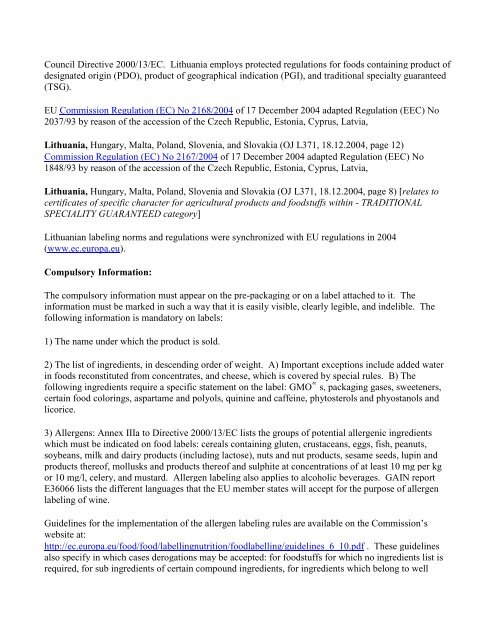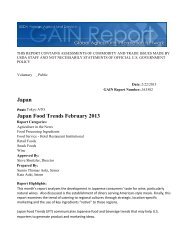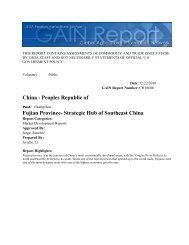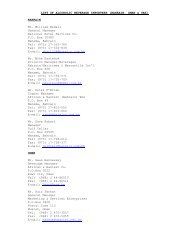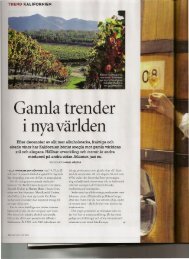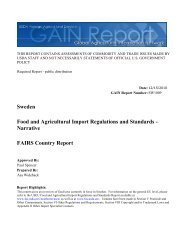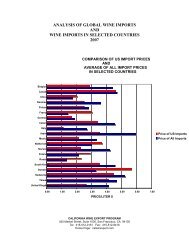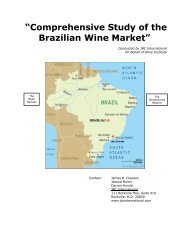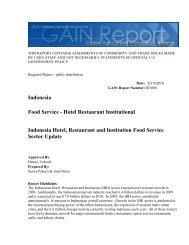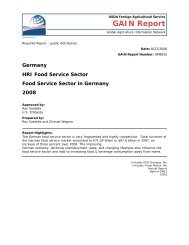FAIRS Country Report Food and Agricultural Import ... - GAIN
FAIRS Country Report Food and Agricultural Import ... - GAIN
FAIRS Country Report Food and Agricultural Import ... - GAIN
You also want an ePaper? Increase the reach of your titles
YUMPU automatically turns print PDFs into web optimized ePapers that Google loves.
Council Directive 2000/13/EC. Lithuania employs protected regulations for foods containing product ofdesignated origin (PDO), product of geographical indication (PGI), <strong>and</strong> traditional specialty guaranteed(TSG).EU Commission Regulation (EC) No 2168/2004 of 17 December 2004 adapted Regulation (EEC) No2037/93 by reason of the accession of the Czech Republic, Estonia, Cyprus, Latvia,Lithuania, Hungary, Malta, Pol<strong>and</strong>, Slovenia, <strong>and</strong> Slovakia (OJ L371, 18.12.2004, page 12)Commission Regulation (EC) No 2167/2004 of 17 December 2004 adapted Regulation (EEC) No1848/93 by reason of the accession of the Czech Republic, Estonia, Cyprus, Latvia,Lithuania, Hungary, Malta, Pol<strong>and</strong>, Slovenia <strong>and</strong> Slovakia (OJ L371, 18.12.2004, page 8) [relates tocertificates of specific character for agricultural products <strong>and</strong> foodstuffs within - TRADITIONALSPECIALITY GUARANTEED category]Lithuanian labeling norms <strong>and</strong> regulations were synchronized with EU regulations in 2004(www.ec.europa.eu).Compulsory Information:The compulsory information must appear on the pre-packaging or on a label attached to it. Theinformation must be marked in such a way that it is easily visible, clearly legible, <strong>and</strong> indelible. Thefollowing information is m<strong>and</strong>atory on labels:1) The name under which the product is sold.2) The list of ingredients, in descending order of weight. A) <strong>Import</strong>ant exceptions include added waterin foods reconstituted from concentrates, <strong>and</strong> cheese, which is covered by special rules. B) Thefollowing ingredients require a specific statement on the label: GMO‟ s, packaging gases, sweeteners,certain food colorings, aspartame <strong>and</strong> polyols, quinine <strong>and</strong> caffeine, phytosterols <strong>and</strong> phyostanols <strong>and</strong>licorice.3) Allergens: Annex IIIa to Directive 2000/13/EC lists the groups of potential allergenic ingredientswhich must be indicated on food labels: cereals containing gluten, crustaceans, eggs, fish, peanuts,soybeans, milk <strong>and</strong> dairy products (including lactose), nuts <strong>and</strong> nut products, sesame seeds, lupin <strong>and</strong>products thereof, mollusks <strong>and</strong> products thereof <strong>and</strong> sulphite at concentrations of at least 10 mg per kgor 10 mg/l, celery, <strong>and</strong> mustard. Allergen labeling also applies to alcoholic beverages. <strong>GAIN</strong> reportE36066 lists the different languages that the EU member states will accept for the purpose of allergenlabeling of wine.Guidelines for the implementation of the allergen labeling rules are available on the Commission’swebsite at:http://ec.europa.eu/food/food/labellingnutrition/foodlabelling/guidelines_6_10.pdf . These guidelinesalso specify in which cases derogations may be accepted: for foodstuffs for which no ingredients list isrequired, for sub ingredients of certain compound ingredients, for ingredients which belong to well


